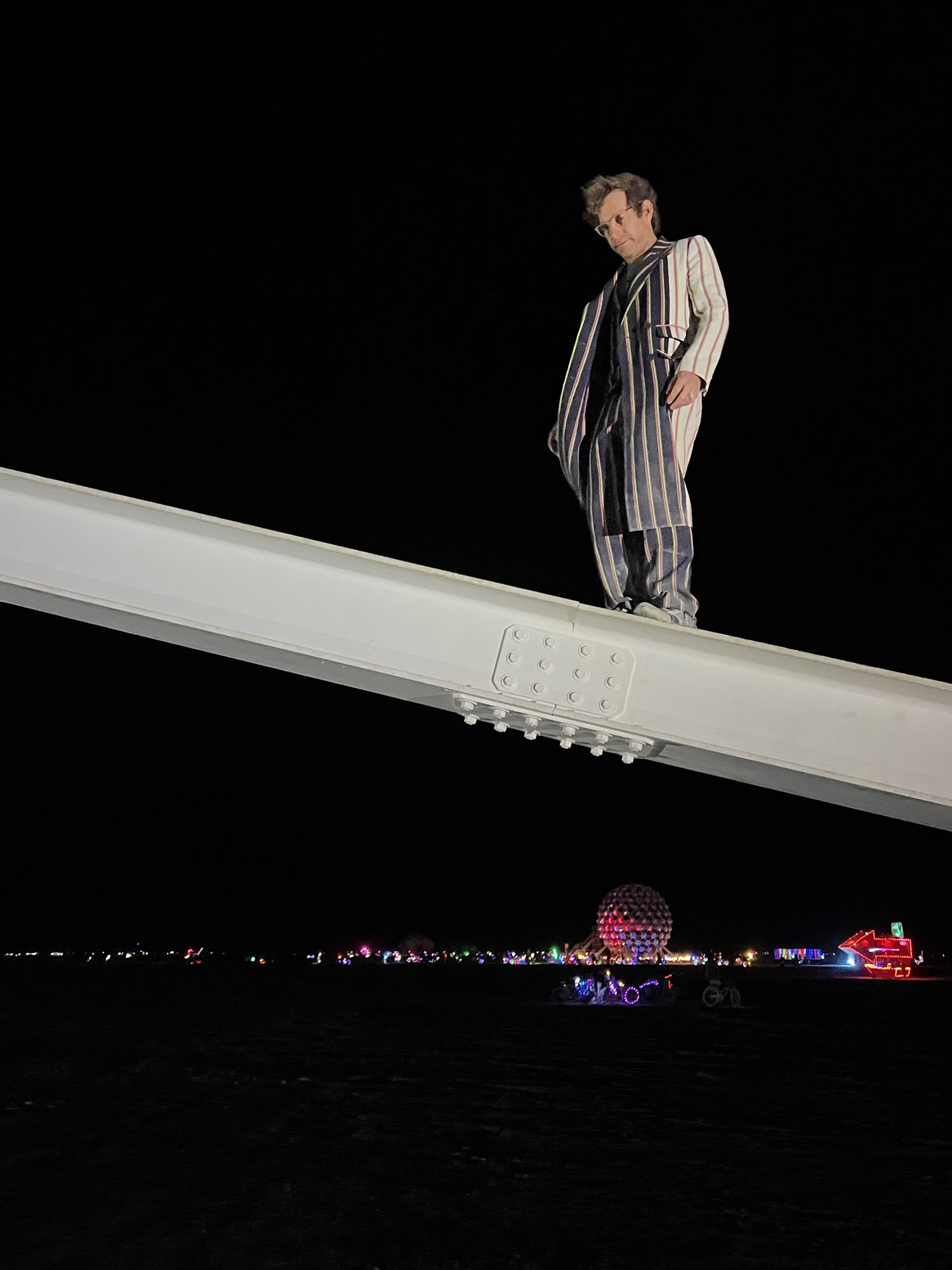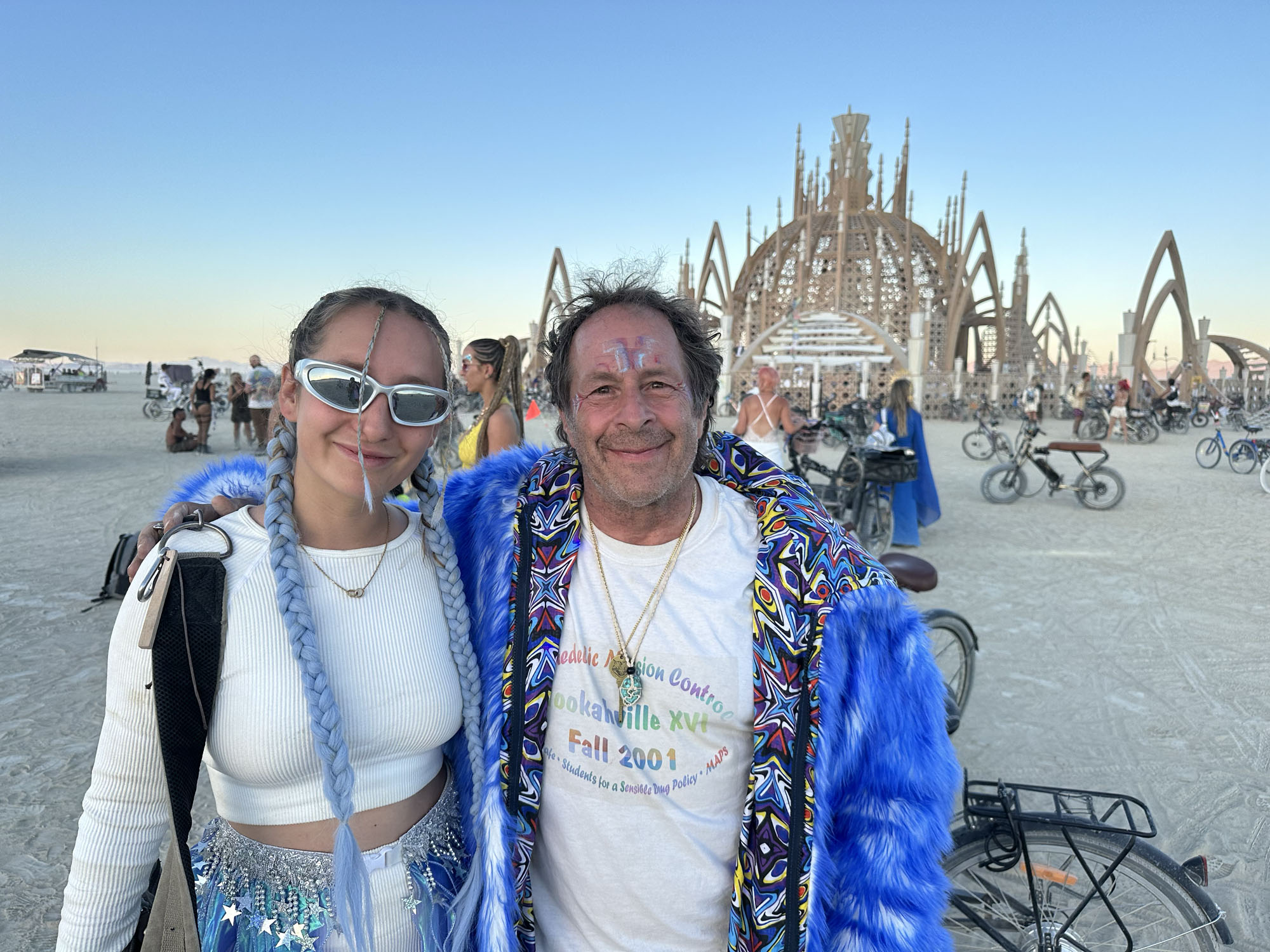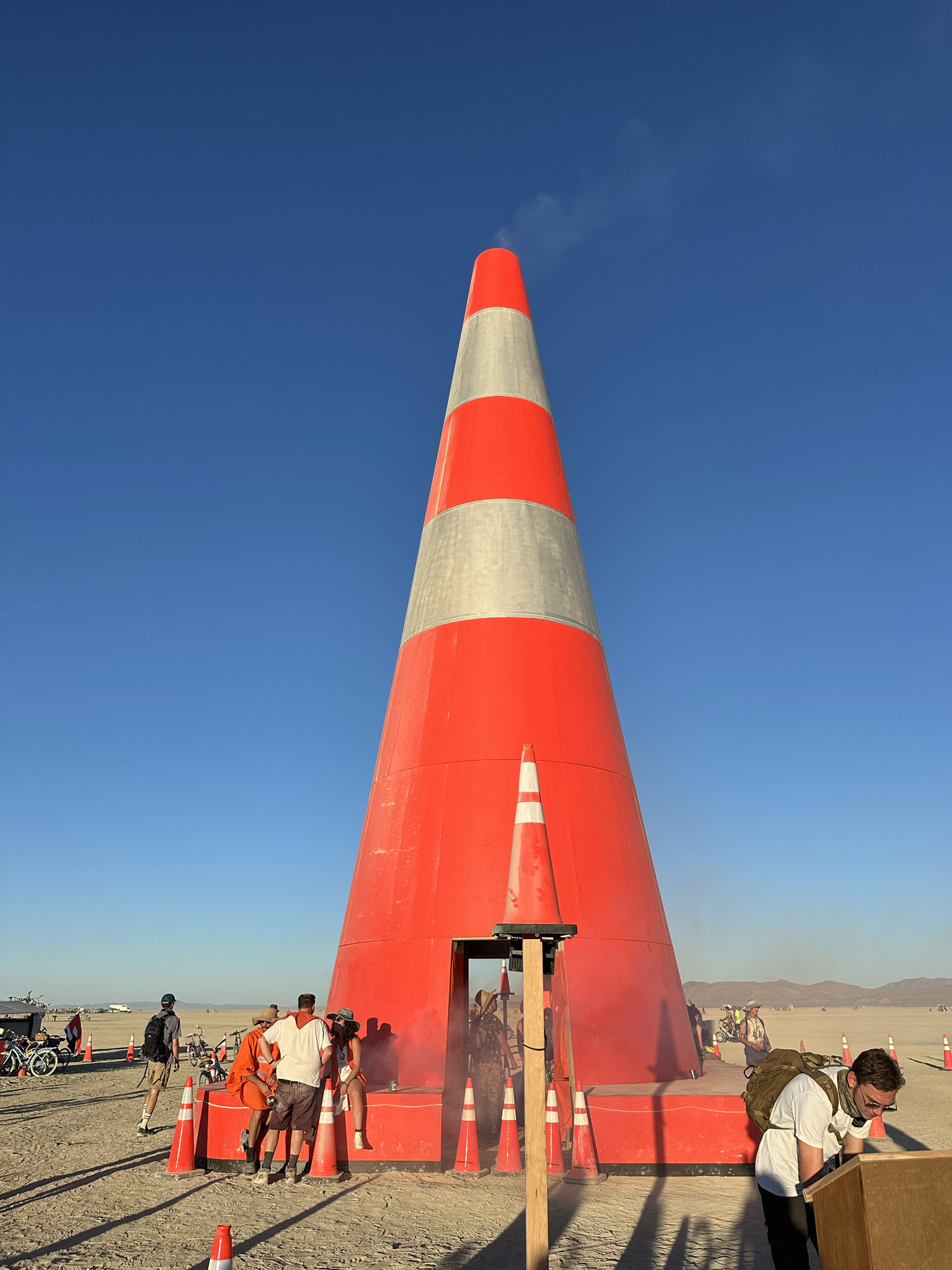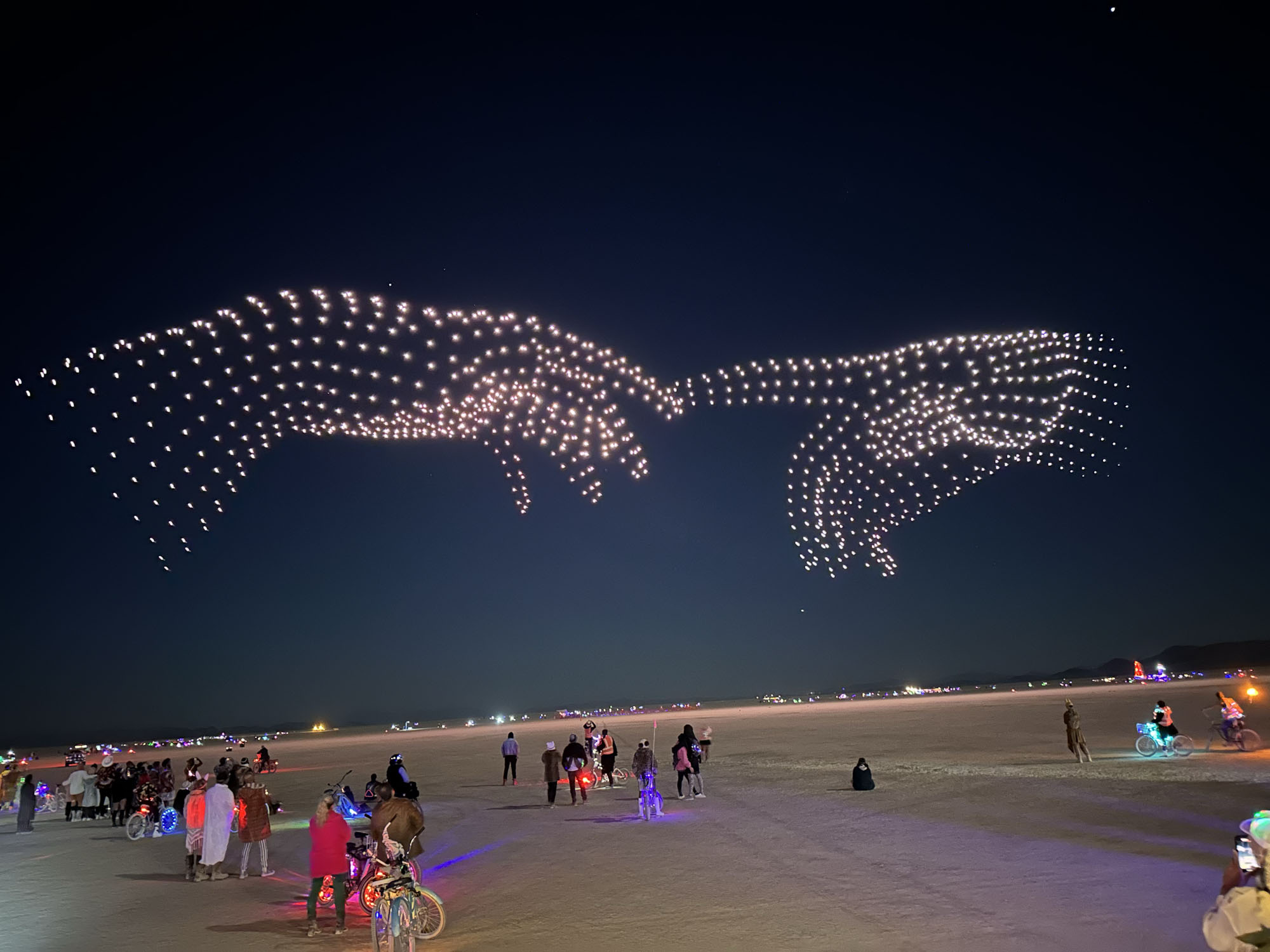
Picture this: it’s 100 degrees, you’re deep in the Nevada desert dancing to disco, and out of the thick dust, artist and Pioneer Works founder Dustin Yellin appears, moon rock in hand. Just when you thought you were as far away as possible from New York, New York finds you. This surreal scene has become an annual tradition of mine come August, when I attend Burning Man, a weeklong, large-scale event focused on community, art, self-expression, and self-reliance that began in the 1980s and has been held annually in the Western United States ever since.
Over the years, I crossed paths with Yellin—who founded Pioneer Works, a nonprofit center devoted to art and science in Red Hook, Brooklyn, in 2012—in the New York and Los Angeles art world. But our friendship really blossomed on the dry lakebed of the Black Rock Desert alongside 80,000 fellow burners called to the same whimsical affair. After this year’s Burning Man, he’ll head back to New York to put the finishing touches on The Politics of Eternity, a 10,000-pound sculpture he will debut at the Armory Show. But first, he will spend a week enjoying other artists’ monumental works in the desert.
While Yellin has more years of festival experience under his belt than I do, we’ve both become attached to the communal tradition. We compared notes about festivals past, Burning Man misconceptions, and how we bring the event into our daily lives making and selling art in New York.
Sophia Cohen: We always run into each other in the funniest circumstances, especially at Burning Man. I’ve only been for the past three years, but I know you’ve had more experience. When did you start going to the festival?
Dustin Yellin: The first time, I believe, was in 2012, and the idea of going to Burning Man was a literal nightmare. I had no desire, no interest. Some friends were going, and they’re like, “Just come.” I decided to go the night before, and I went in very skeptical. The idea of being in a 100-degree desert storm with 80,000 people listening to music that was not folk music sounded like a disaster to my soul. And we get there, I’m in the camper, and they’re like, “Get on the bike, let’s go. We’re going to bike out into the thing.” I was tired from the travel, I had a little bit of a cold, and I was like, “Can I just wait until tomorrow?” They’re like, “No, no, get on the bicycle.” I will never forget that feeling of going through the Playa [the Black Rock Desert playa in Nevada where the event takes place] with the lights and the large-scale artworks. I felt like I was on another planet. I couldn’t even believe this was Earth.

Cohen: A lot of people remember their first Burn as if it were yesterday: your brain expands and realizes that there is a place where people can express themselves in a way that is more for everyone else, versus selfish or introspective. It feels like you’re just looking at a million gifts in front of you.
Yellin: Yeah, there’s such a huge preconceived idea of what it is. It’s almost like a dirty word.
Cohen: People judge you. If they find out you go to Burning Man, they’re like, “Oh, you’re one of those.”
Yellin: Exactly. And I say to them, “Have you been?” And they go, “No, no, no, no, I haven’t been.” And I’m like, “Well, then how can you have so much judgment about something that you actually have no idea about?” It’s an anomaly. There are experiences, like when you go to the Redwoods or Petra for the first time. I don’t know if you want to call them natural phenomena or cultural experiences—it’s a singular version of reality that I think anyone who’s interested in culture should experience at least once.
Cohen: I’d like to talk to you about how it’s changed. In 2012, there weren’t 80,000 people there. There were no iPhones. It was a smaller community.
Yellin: I still think you have to be there. I had my first experience in 2012, and then I didn’t go back until 2018, and then I’ve gone quite often since. The otherworldliness of it and the surprises have stayed the same. There’s a lot of art I see there that I have no interest in. But then there’s art that completely surprises me, like I loved [Benjamin Langholz’s] Beam, which was the I-beam you could walk over. It was really minimal.
Cohen: What people don’t realize about Burning Man is that it is a city. So there are going to be people that you like. There are going to be people that you don’t like. There’s going to be art that you enjoy. There’s going to be art that does not speak to you. Burning Man is one of those places where sometimes you’re confronted with the same piece of art about a hundred times, and sometimes you don’t see a piece of art at all, and maybe on that 30th time you’re like, “Okay, it’s starting to warm up to me.” So I find the art not only to be a landmark in a way, but also a journey within itself to understand it in the context of where you are.
Yellin: I liked the Cone last year [Coney McConeFace by Chris “Kiwi” Hankins and Crew].
Cohen: Oh, the Cone is great. The burning cone!
Yellin: The different kinds of people that I’ve run into there blows my mind. There are people there that I’m like, “I can’t believe you’re here. You do this?” And then there’s the experience of the natural world: when you go out into the desert and watch the sun, the purples and the pinks, and then the dust creating this gauze in the light, it’s spectacular. So even if you just strip away all the people, you’re spending five days in this dry lake bed, and it’s bananas from just that perspective.
Cohen: I was thinking about the time I got caught in my first whiteout. I was on a bike and I was following an art car. So obviously I couldn’t see the art car anymore, but I was just trying to listen to the music. And you’re in that moment where you’re a little bit nervous, you’re trying to gauge how close the music is while not getting run over. I remember the dust kind of cleared, and there was just this art piece that said, “This way, no, this way.” That’s all I saw. And I just laughed. It was a profound moment for me because I was like, “Oh my God, great. A sign. I’m going to know which direction to go.” And it was just a silly artwork. And I remember being like, “This is why I love this place.” Do you have any profound art experiences or pieces that have made you smile?

Yellin: The first thing that comes to mind is the bonds with friends of mine. Last year, we went somewhere on an art car and then a friend who’s an amazing physicist and I decided to walk back home, and we found this little room, and we walked in the room, and it was a sort of life-size kaleidoscope, and it was incredible. There are so many moments where I go on a bike ride with a friend, or I go on a walk with a friend to discover things. Last year, I liked the sculpture made out of signs that have been shot up in Ukraine. Do you remember that?
Cohen: Oh, yeah. That was powerful. Last year, the works were very rooted in what was going on in the world, like the Nova exhibit and that Ukraine exhibit. People have this misconception that Burning Man is an escape, and I think it actually confronts some harsh realities in a safe way.
Yellin: And it’s a critique of capitalism and the history of how communities come together to make a larger community. I’ll find myself serendipitously with groups of people that I know from 10 different parts of my life all colliding at once, which is wild.
Cohen: And how do you, as an artist, come into Burning Man and apply your skills or your knowledge? Do you find yourself getting inspiration from your friends for the next piece?
Yellin: I’m always looking at art through a somewhat critical lens. My friends and I just go for hours on the bikes and stop and go, “What do you think of this? What do you think of that? Oh, let’s climb up on this thing. Let’s climb up on that thing.” It makes me reflect on my own practice when I think about public art or Earthworks. It’s a living sketchbook. I’ll get into visceral arguments with our friends, like, “How the fuck do you think that that’s good?”
Cohen: I’ve been there. I’ve been in awkward scenarios where someone makes me bike super far to see an art piece, and I hate it, and I don’t know what to say.
Yellin: I’ve been meaning to do something there for years. And so I’ve had a bunch of ideas, and I just haven’t gotten to it yet.
Cohen: It’s very different from your daily practice. Where your works are extremely solid and last forever, these are intended to be dismantled and may not be returned.
Yellin: I’ve always told the crew there, though, that I feel like it would be so cool if every year there was a juried competition where one piece would be transported to a sculpture park somewhere else. Each year, that one piece gets to live on, and over the years, it could become this really cool thing. How many works of art are at Burning Man? Are there thousands?
Cohen: There are probably thousands of sanctioned works, and then there are probably thousands of unsanctioned pieces.
Yellin: It’s like an Easter egg hunt.

Cohen: A lot of people say the phrase, “I work and I live for one week.” The idea that every year you make the annual mecca back to Burning Man, and it inspires you for the rest of the year. How do you think that going to Burning Man has helped your approach to building Pioneer Works or navigating the art world in New York? It’s obviously very different from our day-to-day lives. Granted, we are surrounded by creativity in our jobs, but it is not like the warm, fuzzy community that we get to experience for that one week a year.
Yellin: Pioneer Works has been in my consciousness long before I went to Burning Man. But I’ve always been one foot deep in the art world and one foot deeply out. I’m thinking about science, and I’m thinking about music, technology, history, and geology.
Cohen: I find that I’m with a lot of like-minded people at Burning Man who think about how they can better the world. What skills do all of us individually have to give back for the rest of the year? A lot of people lose perspective on the fact that the art world is not the center of the universe. Every year I leave Burning Man, I try to think of one thing I can integrate into my day-to-day life outside of it, whether it’s intentions or random acts of kindness, such as helping a neighbor. Are there any traditions or rituals that you’ve integrated into your day-to-day?
Yellin: In general, my whole orientation is around the idea that the arts and the sciences and nature are the greatest medium we have, or the glue, if you will, that bring people together outside of all of the political differences, the inequities, the struggle and strife and sheer division that we’re seeing in the species right now. Burning Man does this and I think it’s our jobs to bring that sensibility into the world all the time.
Cohen: Speaking of sciences, every time I see you at Burning Man, you always have some fossil or moon rock or something. I’d love for you to tell the readers a little bit about that.
Yellin: Well, I’m obsessed with the unknowable vastness of space. This idea of billions of suns. I’m a little bit obsessed with carbonaceous chondrites, which are meteorites that are older than the Earth. They’re amalgamations older than the sun and have amino acids or, according to some papers, full proteins. And so this idea that the building blocks for life were ubiquitous in the outer asteroid belt before the Earth even came together, blows my mind. It gives you so much relativity to hold as you try to understand reality.
Cohen: I love running into you because you always show me another cool asteroid or something, and I’m always like, “Where did you find this?”
Yellin: Well, I have some good advisors to teach me.
Cohen: What is a fun experience that you’ve had at Burning Man that you’d like to share with people who’ve never been there?
Yellin: Just recently [during the festival in 2023], I had to get to Korea for an exhibition, but the flood had come, and so we woke up to the flood, and I got permission to walk out as one of the first people to the highway to figure out how to get a ride to San Francisco and to get a plane to Seoul.
Cohen: That’s an adventure.
Yellin: That was an incredible memory. I had garbage bags on my feet so that my shoes wouldn’t get taken by the mud.
Cohen: When there’s a will, there’s a way.
Yellin: Always.










 in your life?
in your life?

